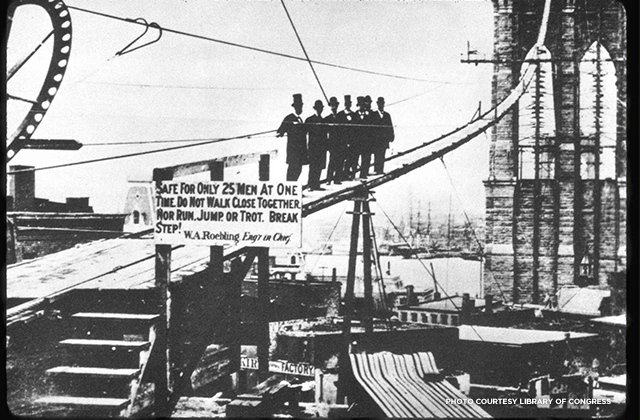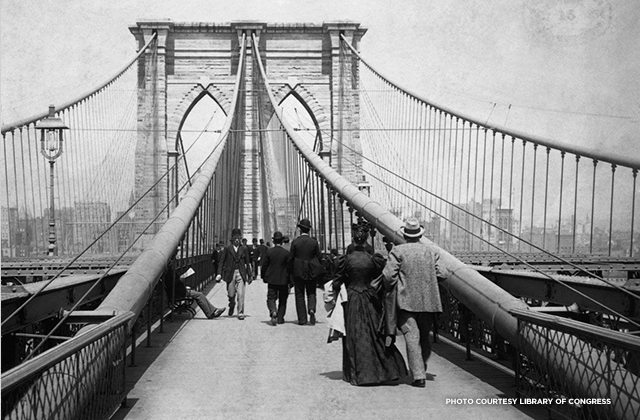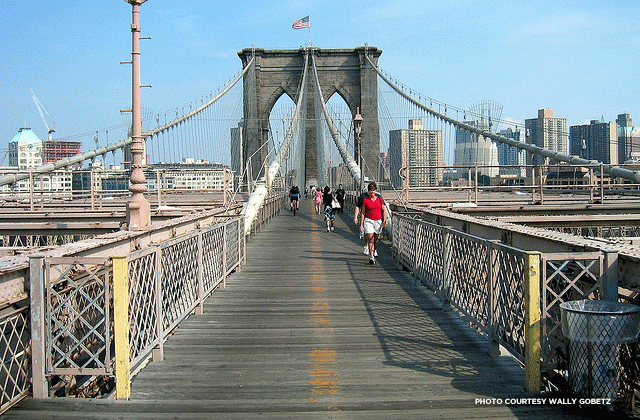Emily Warren Roebling: A Cornerstone in the Construction of the Brooklyn Bridge
Written by Sophia Dembling

Left: A c. 1896 portrait of Emily Warren Roebling. Right: A sculpture at the base of the Brooklyn Bridge honors Emily, Washington, and John Roebling.
The first person ever to ride across the Brooklyn Bridge was the woman behind the man who built it: Emily Warren Roebling, wife of chief engineer Washington Roebling and a key figure in the great bridge's history.
Born in 1843 to Putnam County gentry, Emily Warren was second to youngest of 12 children. Her parents died when she was a teenager, and the task of rearing her and her siblings fell to her brother, 14 years older than she. A general and all-around dashing figure, Governeur Kemble Warren ignited and encouraged Emily's interest in science and taught her orderly ways that would serve her well in her future.
Emily and Washington Roebling met at a military ball in 1864 and were immediately smitten.
"Some people's beauty lies not in the features, but in the varied expression that the countenance will assume under the various emotions," Washington wrote to his sister. "She is ... a most entertaining talker…"
The couple wed in 1865.
Washington was the son of John Roebling, a pioneer in the construction of suspension bridges and the visionary behind the Brooklyn Bridge. John was also one of many men who lost his life constructing the mighty span. After suffering an accident in which his foot was crushed, he ignored medical advice and died 17 days later. Construction on the bridge had barely begun when Washington, also an engineer, inherited the project.

Safety was a concern during construction, which killed John Roebling and gravely injured his son Washington.
Then, during the construction of the caissons that facilitated underwater construction, Washington contracted decompression sickness. Though he survived, he was left an invalid -- weak, easily tired, and reclusive. Thanks to Emily, however, he remained chief engineer of the project through 13 years of construction, all the way to its grand opening.
While Washington could only oversee construction from a window of the couple's Brooklyn Heights home, Emily became his secretary; emissary; eyes, ears, and voice; and stand-in. She was, he said, "a woman of infinite tact and wisest counsel" and "invaluable."
Emily visited the bridge construction site daily, sometimes several times a day, conveying information back and forth between Washington and assistant engineers and contractors. She wrote every piece of correspondence that went from the Roebling house to the bridge office. In the process, she learned enough about bridge engineering to win the admiration and adoration of the assistant engineers who relied on her as a conduit of information.

Pedestrians meander across the bridge's promenade in 1894.
"Once when a manufacturer had been puzzled as to how a particular part of the superstructure should be formed and had come to the Roebling house to get some questions answered, she had made a drawing to show how it could be done, carefully explaining each step," wrote David McCullough in The Great Bridge. This depth of knowledge spurred rumors that she was, in fact, acting as chief engineer on the project, which was not so; Washington retained his position throughout the bridge's construction, despite late-in-the-game efforts to oust him.
As seems inevitable in a civic undertaking of this size, the project whipped up ugly politics, allegations of misconduct, media skepticism, and various distractions and scandals. Through these Emily was a diplomat, soothing and smoothing egos and tempers.
As the bridge neared completion and it was time to test the effect of horse's hooves on the bridge's roadway, Washington wanted Emily to be the first to ride a carriage across. His staff happily complied. She rode an open carriage and carried a rooster to symbolize victory, and as she passed, workers raised their hats and cheered.
On May 24, 1883, when the bridge officially opened amid a frenzy of excitement, Emily Roebling was among the dignitaries participating in opening ceremonies. She, a contingent of marching bands, Brooklyn's Mayor Seth Low, and others crossed from the Brooklyn side; President Chester A. Arthur, Governor (and eventual president) Grover Cleveland, and their entourages crossed from Manhattan.

A modern day view of the bridge, which still draws tourists and New Yorkers alike.
In his speech (one of many in a long day of pomp) the Hon. Abram Hewitt said that the name of Emily Roebling "will thus be inseparably associated with all that is admirable in human nature, and with all that is wonderful in the constructive world of art."
The day's events ended with a reception for dignitaries at the Roeblings, organized by Emily to ensure her husband was able to participate in the great day.
After all this, Emily went on to enroll in NYU in 1899 and earn a law degree. However, she succumbed to cancer in 1903, predeceasing her invalid husband by 23 years.
The bridge was named a National Historic Landmark in 1964. Next time you stroll across -- a delightful and time-honored pastime for local and visitors -- looks for plaques, one on each tower, honoring Emily Warren Roebling, the woman behind (and in front of) the man who built the bridge.
Dallas-based writer Sophia Dembling is author of 100 Places in the USA Every Woman Should Go.


.webp)
